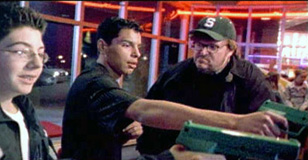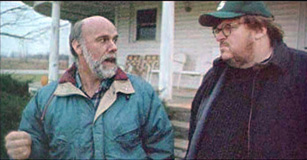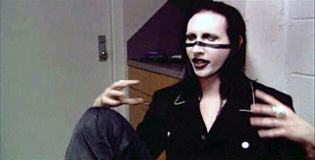Bowling for Columbine (Michael Moore) 2002
 Provocative documentarian Michael Moore comes out prepped
for a strike with Bowling for Columbine, his treatise on American gun
violence, but ends up rolling a complete gutter ball. Gutter ball is an
appropriate term to describe this film, in which Moore masks his seedy
willingness to ambush interviewees emotionally and sleazily distort facts under
the guise of doing a good deed. Always the underdog, heís fighting hard
against just about everyone here, but mostly heís fighting to give a movie
thatís saddled with a terminally unclear thesis some sense of gravitas. In an
effort to demonstrate to us how difficult his quest is he ends up overplaying
his hand greatly while showing us his struggle. No longer is Moore the same
small town guy from Roger & Me, so his attempts to appear unchanged
are unconvincing. He now has clout, but still conducts his interviews
with the same methods as before, and plays stupid or misleads his interviewees
to entrap them. Many of the people he catches on camera are only trying to do
their jobs as police officers, security guards, or public relations workers, and
the superiority that Moore encourages the audience to feel over them is
disgusting. What exactly is the proper response for a corporation or police
officer to have when faced with a tragedy like a school shooting? Iím not sure
there is one, but itís impossible to imagine anyone who could formulate any
reasonable answer with Mooreís camera crew inches from his or her face (and
his merciless editing room techniques close behind). Obviously convinced that
most of the people who he talks with are morons, Moore elides anything cogent
that most of his interviewees with any opposing viewpoint has to say. By the end
of the movie, instead of coming off like a stand-in for the common man, Moore
appears utterly contemptuous of any sort of human fallibility. Heís outraged
at the drop of the hat and tries his darnedest to get his audience fuming too.
Provocative documentarian Michael Moore comes out prepped
for a strike with Bowling for Columbine, his treatise on American gun
violence, but ends up rolling a complete gutter ball. Gutter ball is an
appropriate term to describe this film, in which Moore masks his seedy
willingness to ambush interviewees emotionally and sleazily distort facts under
the guise of doing a good deed. Always the underdog, heís fighting hard
against just about everyone here, but mostly heís fighting to give a movie
thatís saddled with a terminally unclear thesis some sense of gravitas. In an
effort to demonstrate to us how difficult his quest is he ends up overplaying
his hand greatly while showing us his struggle. No longer is Moore the same
small town guy from Roger & Me, so his attempts to appear unchanged
are unconvincing. He now has clout, but still conducts his interviews
with the same methods as before, and plays stupid or misleads his interviewees
to entrap them. Many of the people he catches on camera are only trying to do
their jobs as police officers, security guards, or public relations workers, and
the superiority that Moore encourages the audience to feel over them is
disgusting. What exactly is the proper response for a corporation or police
officer to have when faced with a tragedy like a school shooting? Iím not sure
there is one, but itís impossible to imagine anyone who could formulate any
reasonable answer with Mooreís camera crew inches from his or her face (and
his merciless editing room techniques close behind). Obviously convinced that
most of the people who he talks with are morons, Moore elides anything cogent
that most of his interviewees with any opposing viewpoint has to say. By the end
of the movie, instead of coming off like a stand-in for the common man, Moore
appears utterly contemptuous of any sort of human fallibility. Heís outraged
at the drop of the hat and tries his darnedest to get his audience fuming too.
 Offering non-stop righteous indignation while attempting to
expose the way that the media sells people unwarranted fear and encourages hate,
Moore seems to not realize that his approach is awfully similar to the one that
heís attacking. For example, instead of simply saying that the US murder rate
is roughly five times as bad as the one in Canada, he compares the raw numbers
of crimes with no regard for population differences, making the disparity sound
even greater than it is. That sort of apples and oranges comparison is the rule
here. He has a sociologist say a bit about the increase of the news mediaís
coverage of murders in the United States, but never presents hard data regarding
the same trends in Canada. Instead, we watch him wander into a series of
peoplesí homes (not mentioning whether or not he was able find a single locked
door in the country) as he draws the conclusion that if people are leaving their
doors unlocked, they must feel safe. In my hometown in rural Pennsylvania, we
never locked the doors, but that really doesnít have anything to do with
anything on a national scale.
Offering non-stop righteous indignation while attempting to
expose the way that the media sells people unwarranted fear and encourages hate,
Moore seems to not realize that his approach is awfully similar to the one that
heís attacking. For example, instead of simply saying that the US murder rate
is roughly five times as bad as the one in Canada, he compares the raw numbers
of crimes with no regard for population differences, making the disparity sound
even greater than it is. That sort of apples and oranges comparison is the rule
here. He has a sociologist say a bit about the increase of the news mediaís
coverage of murders in the United States, but never presents hard data regarding
the same trends in Canada. Instead, we watch him wander into a series of
peoplesí homes (not mentioning whether or not he was able find a single locked
door in the country) as he draws the conclusion that if people are leaving their
doors unlocked, they must feel safe. In my hometown in rural Pennsylvania, we
never locked the doors, but that really doesnít have anything to do with
anything on a national scale.
 No one supports school shootings or other gun crimes and as
such itís next to impossible to disagree with most of what Moore says in Bowling
for Columbine. Still, he posits himself as a one-man crusade in an apparent
effort to build his celebrity. Never does he ask fellow anti-gun activists to
talk. American political discourse is founded on the presence of free debate,
but Mooreís approach suggests that if everyone followed his rules, the country
would be saved. Itís unfortunate then that someone so charismatic and
self-confident doesnít have anything more profound to say. His generally
obvious observations are wobbly at best and tied together mostly with that
always-sticky liberal guilt (notice how he intones ďone of the wealthiest
areas in the countyĒ repeatedly). When Moore argues against the right to bear
arms he sets forth an admirable stance, but then soon he also begins bellyaching
about how public schools kicked kids out of class for bringing what were
perceived as weapons to school. He seems to be scrambling about looking for
things to be outraged about and shifting his viewpoint to accommodate each new
bout of indignation, and as such he rarely convinces. The connections between
the aura of fear that surrounds us all and the Columbine shootings is a tenuous
one, but when he extends it to a six-year oldís gun murder that occurred in his
hometown, the thread snaps. Itís difficult to think that first graders have a
finger on the pulse of the undercurrent of Puritanical fear that Moore argues
runs deep within our countryís bloodstream and manifests itself in our news
media.
No one supports school shootings or other gun crimes and as
such itís next to impossible to disagree with most of what Moore says in Bowling
for Columbine. Still, he posits himself as a one-man crusade in an apparent
effort to build his celebrity. Never does he ask fellow anti-gun activists to
talk. American political discourse is founded on the presence of free debate,
but Mooreís approach suggests that if everyone followed his rules, the country
would be saved. Itís unfortunate then that someone so charismatic and
self-confident doesnít have anything more profound to say. His generally
obvious observations are wobbly at best and tied together mostly with that
always-sticky liberal guilt (notice how he intones ďone of the wealthiest
areas in the countyĒ repeatedly). When Moore argues against the right to bear
arms he sets forth an admirable stance, but then soon he also begins bellyaching
about how public schools kicked kids out of class for bringing what were
perceived as weapons to school. He seems to be scrambling about looking for
things to be outraged about and shifting his viewpoint to accommodate each new
bout of indignation, and as such he rarely convinces. The connections between
the aura of fear that surrounds us all and the Columbine shootings is a tenuous
one, but when he extends it to a six-year oldís gun murder that occurred in his
hometown, the thread snaps. Itís difficult to think that first graders have a
finger on the pulse of the undercurrent of Puritanical fear that Moore argues
runs deep within our countryís bloodstream and manifests itself in our news
media.
 The problem Moore sees with media manipulation can only be
solved by freethinking in the public, but the director manipulates facts and
edits the film so the audience can only realistically be expected to see the
information presented in the film in the light that he desires. By leading his
audience to a singular conclusion in the manner that he does, Moore only makes
the audience think that they are drawing their own conclusions. They arenít
though. Watching the movie is like looking at a connect-the-dots puzzle with the
dots already connected for you. Still, the gratification that most of the
audience will feel after watching the film (evidenced by the applause that
filled the auditorium after I saw it) is calculated so that the audience thinks
Moore is helping them see the light, when he is in fact manipulating them.
Because he presents himself as an everyman, but at the same time presents
himself as superior to everyone who hasnít suffered greatly, the audience can
easily align with Moore and tell themselves, ďIím glad Iím not part
of the problem!Ē simply because they watched his film (and essentially bought
into the rage heís selling). I suppose the irony is that free thinkers wonít
need this film since they will have already considered all of the rather
obvious ideas presented in it. For the record, I donít have a handgun, and I
donít watch the news. I donít think that this makes me superior to anyone,
but I certainly donít feel enveloped in fear as Moore suggests all Americans
do.
The problem Moore sees with media manipulation can only be
solved by freethinking in the public, but the director manipulates facts and
edits the film so the audience can only realistically be expected to see the
information presented in the film in the light that he desires. By leading his
audience to a singular conclusion in the manner that he does, Moore only makes
the audience think that they are drawing their own conclusions. They arenít
though. Watching the movie is like looking at a connect-the-dots puzzle with the
dots already connected for you. Still, the gratification that most of the
audience will feel after watching the film (evidenced by the applause that
filled the auditorium after I saw it) is calculated so that the audience thinks
Moore is helping them see the light, when he is in fact manipulating them.
Because he presents himself as an everyman, but at the same time presents
himself as superior to everyone who hasnít suffered greatly, the audience can
easily align with Moore and tell themselves, ďIím glad Iím not part
of the problem!Ē simply because they watched his film (and essentially bought
into the rage heís selling). I suppose the irony is that free thinkers wonít
need this film since they will have already considered all of the rather
obvious ideas presented in it. For the record, I donít have a handgun, and I
donít watch the news. I donít think that this makes me superior to anyone,
but I certainly donít feel enveloped in fear as Moore suggests all Americans
do.
 That line of thinking becomes irrelevant to Moore anyway in
Bowlingís final act, where he pulls two audacious stunts that ignore
the position that heís built up until that point. First, he recruits a duo of
survivors from the Columbine school attacks to travel with him to the K-Mart
headquarters so that they might convince the retailer, who sold the bullets used
in the attack, to stop selling handgun ammunition. The entire enterprise feels
completely misguided and opportunistic since Moore has essentially stated all
along in his film that the availability of handguns and ammunition is not the
cause of gun violence. The stunt feels like a sick photo opportunity (Moore
brings along the media heís attacking to apply pressure on K-Mart) as they
fight a fight that doesnít really need to be fought. The obvious question
arises about whether those kids would have felt compelled to rally against
K-Mart had Moore not befriended them, but perhaps the more pertinent question is
whether or not Moore would have gone with them had he not been able to bring his
camera along.
That line of thinking becomes irrelevant to Moore anyway in
Bowlingís final act, where he pulls two audacious stunts that ignore
the position that heís built up until that point. First, he recruits a duo of
survivors from the Columbine school attacks to travel with him to the K-Mart
headquarters so that they might convince the retailer, who sold the bullets used
in the attack, to stop selling handgun ammunition. The entire enterprise feels
completely misguided and opportunistic since Moore has essentially stated all
along in his film that the availability of handguns and ammunition is not the
cause of gun violence. The stunt feels like a sick photo opportunity (Moore
brings along the media heís attacking to apply pressure on K-Mart) as they
fight a fight that doesnít really need to be fought. The obvious question
arises about whether those kids would have felt compelled to rally against
K-Mart had Moore not befriended them, but perhaps the more pertinent question is
whether or not Moore would have gone with them had he not been able to bring his
camera along.
 The second of his attacks, which seems much more personal,
singles out NRA spokesperson Charlton Heston. After being invited into his home
under false pretenses, Moore begins aggressively questioning Heston about the
causes of gun violence. Even though heís conditioned his audience to only
accept ďthe climate of fearĒ as the answer to this question, Moore doesnít
mention the mediaís involvement when talking with Heston. He has him pegged as
a bad guy, and has no interest in trying to sway his opinion. Instead of asking
tough questions that would prompt intelligent responses, he discards his thesis
to mug for the camera, making me wonder how much stock Moore even places in his
own theories to begin with. As a result, the discussion feels less like a debate
than an attempt to embarrass the interviewee, and Moore comes off as an ogre as
a result. When Heston wises up to Mooreís tactics and storms off, the film
expects us to boo Heston for walking away from a sneak attack (just as it
expects us to do when Dick Clark responds similarly earlier in the film), but I
felt like booing Moore for stooping so low. It only gets worse from there as
Moore turns on his concern for the victims of school shootings and pleads with
Heston to look at a photo of a little girl who was shot that heís brought
along with him. This revolting display is typical of Bowling for Columbineís
approach. Even the few quality bits of footage included, such as the interview
with Marilyn Manson in which the rock singer first proposes the climate of fear
theory that Moore spends the rest of the film unsuccessfully attempting to
explain or the bit of found news footage that correlates ďAfricanizedĒ
killer bees with the mediaís inherent racism, barely register in comparison
with Mooreís oversized ego.
The second of his attacks, which seems much more personal,
singles out NRA spokesperson Charlton Heston. After being invited into his home
under false pretenses, Moore begins aggressively questioning Heston about the
causes of gun violence. Even though heís conditioned his audience to only
accept ďthe climate of fearĒ as the answer to this question, Moore doesnít
mention the mediaís involvement when talking with Heston. He has him pegged as
a bad guy, and has no interest in trying to sway his opinion. Instead of asking
tough questions that would prompt intelligent responses, he discards his thesis
to mug for the camera, making me wonder how much stock Moore even places in his
own theories to begin with. As a result, the discussion feels less like a debate
than an attempt to embarrass the interviewee, and Moore comes off as an ogre as
a result. When Heston wises up to Mooreís tactics and storms off, the film
expects us to boo Heston for walking away from a sneak attack (just as it
expects us to do when Dick Clark responds similarly earlier in the film), but I
felt like booing Moore for stooping so low. It only gets worse from there as
Moore turns on his concern for the victims of school shootings and pleads with
Heston to look at a photo of a little girl who was shot that heís brought
along with him. This revolting display is typical of Bowling for Columbineís
approach. Even the few quality bits of footage included, such as the interview
with Marilyn Manson in which the rock singer first proposes the climate of fear
theory that Moore spends the rest of the film unsuccessfully attempting to
explain or the bit of found news footage that correlates ďAfricanizedĒ
killer bees with the mediaís inherent racism, barely register in comparison
with Mooreís oversized ego.
*
10-27-02
Jeremy Heilman